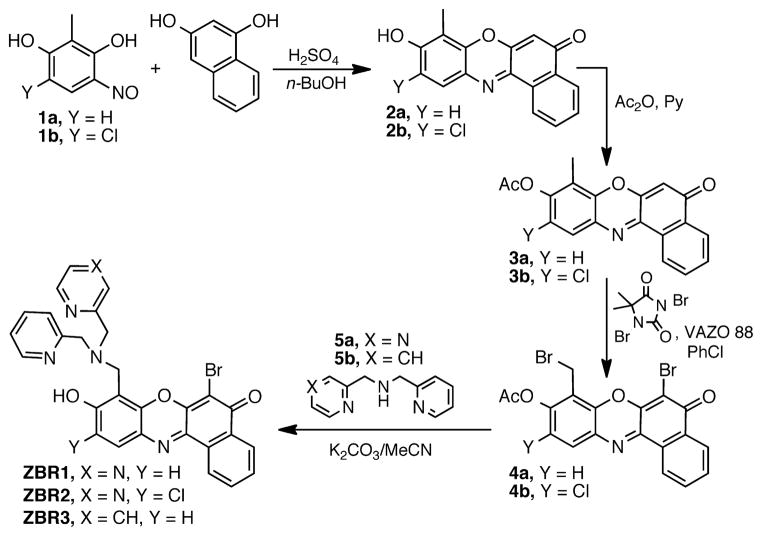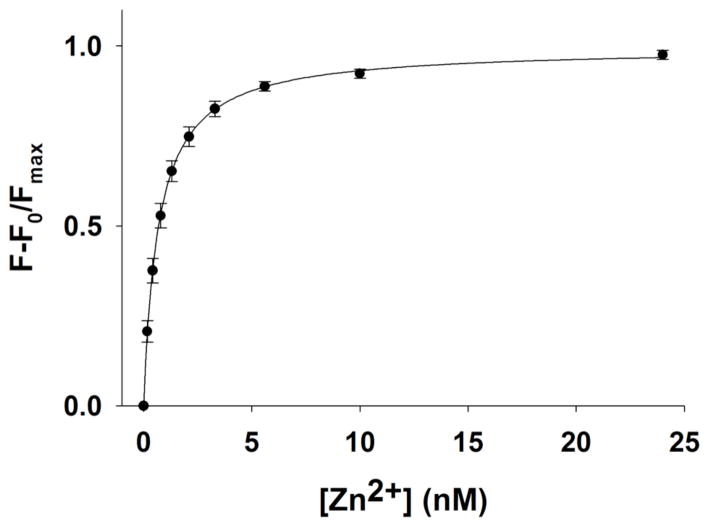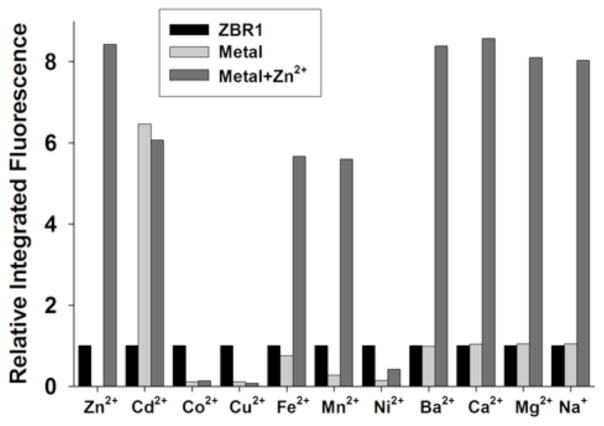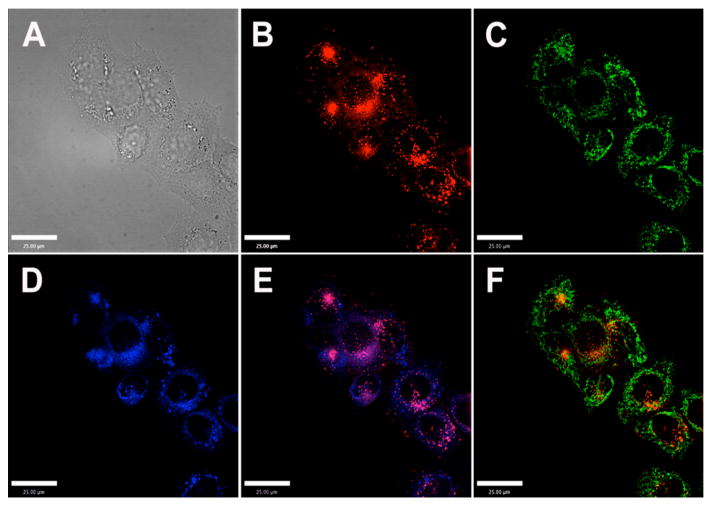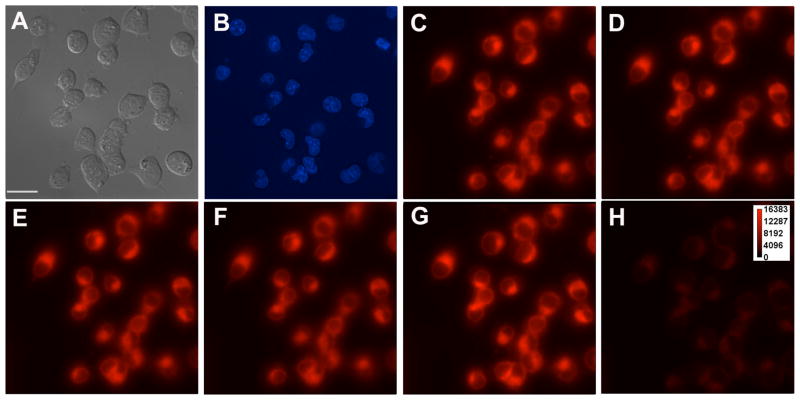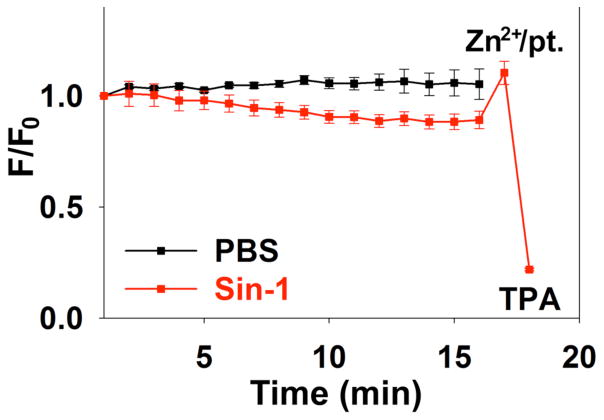Abstract
Zn2+ plays essential roles in biology, and the homeostasis of Zn2+ is tightly regulated in all cells. Subcellular distribution and trafficking of labile Zn2+, and its interrelation with reactive nitrogen species, are poorly understood due to the scarcity of appropriate imaging tools. We report a new family of red-emitting fluorescent sensors for labile Zn2+, ZBR1-3, based on a benzoresorufin platform functionalized with dipicolylamine or picolylamine-derived metal binding groups. In combination, the pendant amines and fluorophore afford an [N3O] binding motif that resembles that of previously reported fluorescein-based sensors of the Zinpyr family, reproducing well their binding capabilities and yielding comparable Kd values in the subnanomolar and picomolar range. The ZBR sensors display up to 8.4-fold emission fluorescence enhancement upon Zn2+ binding in the cuvette, with similar responses obtained in live cells using standard wide-field fluorescence microscopy imaging. The new sensors localize spontaneously in the endoplasmic reticulum (ER) of various tested cell lines, allowing for organelle-specific monitoring of zinc levels in live cells. Study of ER zinc levels in neural stem cells (NSC) treated with a peroxynitrite generator, Sin-1, revealed an immediate decrease in labile Zn2+ thus providing evidence for a direct connection between ER stress and ER Zn2+ homeostasis.
Keywords: labile zinc, zinc fluorescent sensor, unfolded protein response, fluorescence imaging, benzoresorufin
Introduction
Zinc is a d-block element essential for all living organisms.1,2 Zn2+ ions play various key roles in biological systems including enzymatic catalysis, stabilization of protein structures and modulation of interactions between macromolecules.3 The percentage of genes coding for zinc-bound proteins is estimated to be 10%, consistent with the value found in the known proteome.4,5 The total concentration of Zn2+ in mammalian cells is estimated to be in the range of 100 to 500 μM;6 the largest fraction is tightly bound to metalloproteins, whereas a smaller portion is loosely bound to various readily exchangeable molecules.7 Cytosolic pools of labile Zn2+ participate in signaling pathways associated with different physiological and pathological events.8–10 The intracellular sources of these pools of exchangeable zinc, however, remain unclear in many systems.
Zinc and reactive nitrogen species (RNS) such as nitric oxide (NO) and peroxynitrite (ONOO−) have physiological roles in the nervous system and are implicated in neurological dysfunction.11–13 Exposure of neurons to high concentrations of exogenous NO leads to the formation of peroxynitrite and causes Zn2+ release from intracellular stores. In turn, higher concentrations of labile Zn2+ induce mitochondrial dysfunction and increased production of reactive oxygen species, ROS, thus resulting in amplification of the apoptotic signaling pathway contributing to neurodegeneration.12 High concentrations of NO and peroxynitrite also have an effect on the endoplasmic reticulum (ER), inducing ER stress and activating a cellular stress response named unfolded protein response (UPR).14,15 A number of neurodegenerative disorders such as Alzheimer’s disease, Parkinson’s disease, prion disease, Huntington’s disease, frontotemporal dementia, amyotrophic lateral sclerosis, and Ehlers–Danlos syndrome are all characterized by the accumulation and aggregation of misfolded proteins in the ER.16,17 Previous studies demonstrated that deletion of zinc transporters and zinc deficiency in the ER up-regulates the UPR.18,19
The temporal, spatial, and functional characteristics of the interplay between RNS, ROS, and labile Zn2+ in neurodegeneration are still far from clear. New approaches are needed to track the source and destination of these species in live cells and tissues. In particular, convenient tools that allow for easy visualization of the fluctuations of labile Zn2+ in specific organelles and its translocation to or from the cytosol may shed some light on the role of Zn2+ in these pathologies. Neural stem cells (NSC) are a class of cells that can proliferate through symmetric division and differentiate into neurons and glial cells through asymmetric division.20 Owing to their ability to self-renew and produce neurons and glial cells, NSCs are a powerful resource to study synaptic plasticity and neuronal disorders.21–26 In this work we employ NSCs to investigate the interrelation between RNS and zinc homeostasis with potential implications for understanding neurodegenerative processes.
Over the last two decades, our group has developed a large number of fluorescein-based fluorescent sensors for mobile zinc with apparent dissociation constants spanning the range from sub-nanomolar to sub-millimolar.27 Among these, the Zinpyr28 (ZP) family is a series of probes containing dipicolylamine (DPA) or DPA-analog metal binding moieties with dissociation constants in the nanomolar range,27,29,30 which have proved to be particularly useful for the imaging of Zn2+ distribution, uptake, and translocation in different types of cells.12,31–34 Fluorescein-based sensors, however, are limited by their high energy absorptions and small Stokes shifts. Cellular auto-fluorescence in the corresponding spectral window leads to a high background signal that reduces the distinguishable fluorescence turn-on of probes associated with Zn2+ binding, compared to the response obtained in the cuvette. For biological imaging, sensors emitting in the red or near infrared region are thus desirable.
In our continuing effort to improve the tools available for the study of labile Zn2+ in memory formation and neurodegeneration, we herein report the design of a new series of probes based on a benzoresorufin fluorophore with a DPA or DPA-analog metal binding group. The resulting red-emitting probes display a conserved [N3O] zinc-binding motif similar to that offered by ZP analogues (Fig. 1), which endows them with similar dissociation constants to their green-emitting counterparts. We employed the new probes to study zinc homeostasis in NSCs and demonstrate that the peroxy-nitrite generator Sin-1 can modulate labile Zn2+ in the ER. We thus provide direct evidence of the interplay between RNS-induced ER stress and Zn2+ signaling.
Figure 1.
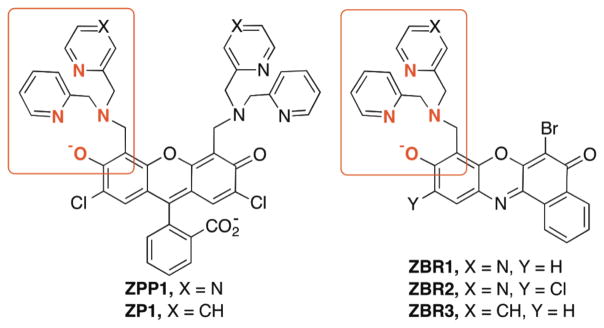
General structures of ZP and ZBR zinc sensor families
Materials and Methods
Synthetic Materials and Methods
All synthetic procedures were performed under a nitrogen atmosphere unless otherwise specified. 4-Chloro-2-methylresorcinol35, 6-bromo-8-(bromo-methyl)-5-oxo-benzo[a]phenoxazin-9-yl acetate36 and (2-picolyl)-(pyrazin-2-yl-methyl)amine33 were synthesized according to reported procedures. All other reagents were purchased from commercial sources and used as received. Solvents were purified and degassed by standard procedures. NMR spectra were acquired on Bruker Avance 400 spectrometers. 1H NMR chemical shifts are reported in ppm relative to SiMe4 (δ= 0) and were referenced internally with respect to residual protons in the solvent (δ = 7.26 for CHCl3, 3.31 for CD2HOD, 2.50 for DMSO-d5). 13C NMR chemical shifts are reported in ppm relative to SiMe4 (δ = 0) and were referenced internally with respect to the solvent signal (δ = 77.16 for CDCl3, 49.00 for CD3OD, 39.52 for DMSO-d6). Low-resolution mass spectra were acquired on an Agilent 1100 Series LC/MSD Trap spectrometer, using electrospray ionization. High-resolution mass spectrometry (HRMS) was conducted by staff at the MIT Department of Chemistry Instrumentation Facility on a Bruker Daltonics APEXIV 4.7 Tesla FT-ICR-MS.
Synthesis of 4-Chloro-6-nitroso-2-methylresorcinol, 1b
A solution of 4-chloro-2-methylresorcinol (2.00 g, 12.6 mmol) in ethanol (12.5 mL) was cooled to 0 °C and treated with a solution of KOH (0.991 g, 17.6 mmol) in water (4.2 mL), followed by isoamyl nitrite (2.0 mL, 14.9 mmol) added dropwise. After addition was complete, the solution was allowed to warm to room temperature and stirred for 1.5 h. The mixture was acidified to pH ~2 by addition of 1 M HCl, and stirring was continued at room temperature, open to air, for 1 h. The yellow precipitate was collected by filtration, washed with a 1:1 mixture of ethanol:water (2×10 mL) followed by water (30 mL), and dried under vacuum to give 4-chloro-6-nitroso-2-methylresorcinol as a bright yellow powder (1.95 g, 82%). 1H NMR (400 MHz, MeOH-d4, room temperature): δ 7.70 (s, 1H), 1.89 (s, 3H). 13C{1H} NMR (100.6 MHz, MeOH-d4) 181.8, 158.5, 144.8, 137.8, 119.3, 115.2, 8.4. ESI-MS (m/z): [M+H+] calcd for C7H6ClNO3, 188.0; found 188.1.
Synthesis of 10-Chloro-9-hydroxy-8-methyl-5-ben-zo[a]-phenoxazone, 2b
A suspension of 4-chloro-6-nitroso-2-methylresorcinol (0.750 g, 4.00 mmol) in n-butanol (7.5 mL) was mixed with a solution of 1,3-dihydroxynaphthalene (0.640 g, 4.00 mmol) in n-butanol (7.5 mL) and heated to 50 °C. Concentrated sulfuric acid (1.5 mL) was added dropwise to the warm reaction mixture open to air, and heating was continued for additional 1 h. The suspension was then allowed to stand at room temperature overnight. The solid was collected by centrifugation and the pellet was washed with a 1:1 mixture ethanol:n-butanol (2×10 mL), followed by 1:1 ethanol:water (5 mL), and dried under vacuum to give resorufin 2b as a brown-red powder (1.03 g, 80% yield). The crude product was used in the next step without further purification.
Synthesis of 10-Chloro-8-methyl-5-oxo-benzo[a]-phenoxazin-9-yl acetate, 3b
A suspension of 10-chloro-9-hydroxy-8-methyl-5-benzo[a]phenoxazone, 2b, (1.00 g, 3.21 mmol) in acetic anhydride (13 mL) was treated with pyridine (1.3 mL) and heated to 100 °C for 3 h with vigorous stirring. The resulting suspension was allowed to stand at room temperature for 12 h. The solid was collected by filtration, washed with fresh acetic anhydride (5 mL), followed by water (2×5 mL), and dried under vacuum to give the acetate product as an orange-yellow solid (1.01 g, 89%). 1H NMR (400 MHz, CDCl3, room temperature): δ 8.57 (m, 1H), 8.22 (m, 1H), 7.72 (m, 2H), 7.68 (s, 1H), 6.38 (s, 1H), 2.42 (s, 3H), 2.25 (s, 3H). 13C{1H} NMR (100.6 MHz, CDCl3) 183.7, 167.8, 150.6, 147.7, 147.4, 141.3, 132.3, 132.3, 131.0, 130.9, 127.4, 126.0, 124.9, 123.7, 120.8, 108.0, 20.4, 9.5. ESI-MS (m/z): [M+H+] calcd for C19H12ClNO4, 354.1; found 354.0.
Synthesis of 6-Bromo-8-(bromomethyl)-10-chloro-5-oxo-benzo[a]phenoxazin-9-yl acetate, 4b
A mixture of benzoresorufin acetate 3b (800 mg, 2.26 mmol) and 1,3-dibromo-5,5-dimethylhydantoin (1.426 g, 4.98 mmol) in chlorobenzene (90 mL) was treated with Vazo 88 (184 mg, 0.746 mmol) and acetic acid (100 mL) and heated to 50 °C for 48 h, after which abundant precipitate of the ring-brominated intermediate was observed. The suspension was then heated to 60 °C to aid in re-dissolving the intermediate, and aliquots were monitored by 1H NMR until reaction completion (1–4 more days). The reaction mixture was washed with water at 60 °C (3×100 mL) and once with brine, then dried over Na2SO4 and evaporated to an orange solid (1.021 g, 88%). 1H NMR (400 MHz, CDCl3, room temperature): δ 8.67 (d, 3J = 7 Hz, 1H), 8.36 (d, 3J = 7 Hz, 1H), 7.93 (s, 1H), 7.82 (t, 3J = 7 Hz, 1H), 7.80 (t, 3J = 7 Hz, 1H), 4.67 (s, 2H), 2.50 (s, 3H). 13C{1H} NMR (100.6 MHz, CDCl3) 177.4, 167.3, 147.7, 147.6, 147.2, 140.9, 132.9, 132.8, 131.4, 131.3, 130.0, 127.2, 125.3, 125.2, 121.0, 34.0, 20.6. ESI-MS (m/z): [M+H+] calcd for C19H10Br2ClNO4, 511.9; found 511.8.
Synthesis of ZBR1
A mixture of bromomethyl benzophenoxazone 4a (150 mg, 0.314 mmol), (2-picolyl)(pyrazin-2-yl-methyl)amine (190 mg, 0.949 mmol), and potassium carbonate (435 mg, 3.14 mmol) in acetonitrile (6 mL) was heated to reflux for 3 h. The mixture was allowed to cool to room temperature and diluted with saturated NH4Cl and dichloromethane in equal amounts. The organic phase was separated and washed once more with NH4Cl, then 3 times with water, once with brine, and then dried over Na2SO4 and evaporated. The residue was triturated with 1:1 Et2O/pentane to give ZBR1 as a red-brown powder (108.4 mg, 62%). The product may be recrystallized by slow diffusion of 1:1 Et2O/pentane into a dichloromethane solution of the compound to yield ZBR1·CH2Cl2. 1H NMR (400 MHz, CDCl3, room temperature): δ 8.69 (d, 3J = 7 Hz, 1H), 8.64 (m, 2H), 8.48 (s, 1H), 8.43 (d, 4J = 2 Hz, 1H), 8.38 (d, 3J = 7 Hz, 1H), 7.78 (t, 3J = 7 Hz, 1H), 7.74-7.69 (m, 3H), 7.27 (m, overlapping solvent), 7.03 (d, 3J = 8 Hz, 1H), 4.25 (s, 2H), 4.05 (s, 4H). 13C{1H} NMR (100.6 MHz, CDCl3) 177.5, 162.8, 156.9, 153.9, 148.8, 148.7, 145.5, 143.8, 143.62, 143.56, 141.5, 137.5, 132.2, 131.2, 130.8, 130.6, 126.8, 126.5, 124.5, 133.4, 122.9, 116.1, 110.0, 105.7, 58.4, 57.3, 47.8. ESI-HRMS (m/z): [M+H+] calcd for C28H20BrN5O3, 556.0822; found 556.0808. Anal. Calcd for C28H19BrN5O3: C, 60.66; H, 3.64; N, 12.63. Found: C, 60.60; H, 3.78; N, 12.43.
Synthesis of ZBR2
A mixture of bromomethyl benzophenoxazone 4b (150 mg, 0.293 mmol), (2-picolyl)(pyrazin-2-yl-methyl)amine (177 mg, 0.884 mmol), and potassium carbonate (405 mg, 2.93 mmol) in acetonitrile (6 mL) was heated to reflux for 3 h. The mixture was allowed to cool to room temperature and diluted with saturated NH4Cl and dichloromethane in equal amounts. The organic phase was separated and washed once more with NH4Cl, 3 times with water, once with brine, and then dried over Na2SO4 and evaporated. The residue was triturated with 1:1 Et2O/pentane to give ZBR2 as a red-brown powder (88.0 mg, 51%). The product may be recrystallized by slow liquid diffusion of 1:1 Et2O/pentane into a dichloromethane solution of the compound. 1H NMR (400 MHz, CDCl3, room temperature): δ 8.70 (d, 3J = 5 Hz, 1H), 8.65 (m, 2H), 8.49 (s, 1H), 8.44 (s, 1H), 8.36 (d, 3J = 8 Hz, 1H), 7.84 (s, 1H), 7.79-7.69 (m, 3H), 7.31-7.26 (m, overlapping solvent), 4.26 (s, 2H), 4.04 (s, 4H). 13C{1H} NMR (100.6 MHz, CDCl3) 177.4, 158.2, 156.5, 153.7, 148.7, 148.5, 145.4, 143.8, 143.7, 142.7, 142.1, 137.8, 132.4, 131.6, 131.2, 130.6, 129.8, 126.9, 126.1, 124.7, 123.5, 123.0, 120.3, 111.1, 106.3, 58.0, 57.3, 48.0. ESI-HRMS (m/z): [M+H+] calcd for C28H19BrClN5O3, 590.0424; found 590.0413.
Synthesis of ZBR3
A mixture of bromomethyl benzophenoxazone 4a (150.0 mg, 0.314 mmol), di(2-picolyl)amine (190 mg, 0.954 mmol), and potassium carbonate (435.0 mg, 3.14 mmol) in acetonitrile (6 mL) was heated to reflux for 3 h. The mixture was allowed to cool to room temperature and diluted with equal volumes of saturated NH4Cl and dichloromethane (50 mL each). The organic phase was separated and washed once more with NH4Cl, then 3 times with water, once with brine, and then dried over Na2SO4 and evaporated. The residue was triturated with 1:1 Et2O/pentane to give ZBR3 as a red-brown powder (96.1 mg, 55%). The product may be recrystallized by slow liquid diffusion (layering) of 1:1 Et2O/pentane into a dichloromethane solution of the compound to yield red-brown needles. 1H NMR (400 MHz, CDCl3, room temperature): δ 8.70 (d, 3J = 5 Hz, 1H), 8.65 (m, 2H), 8.49 (s, 1H), 8.44 (s, 1H), 8.36 (d, 3J = 8 Hz, 1H), 7.84 (s, 1H), 7.79-7.69 (m, 3H), 7.31-7.26 (m, overlapping solvent), 4.26 (s, 2H), 4.04 (s, 4H). 13C{1H} NMR (100.6 MHz, CDCl3) 177.4, 158.2, 156.5, 153.7, 148.7, 148.5, 145.4, 143.8, 143.7, 142.7, 142.1, 137.8, 132.4, 131.6, 131.2, 130.6, 129.8, 126.9, 126.1, 124.7, 123.5, 123.0, 120.3, 111.1, 106.3, 58.0, 57.3, 48.0. HRMS (m/z): [M-H+] calcd for C29H21BrN4O3, 551.0724; found 551.0719.
Spectroscopic methods
All aqueous solutions were prepared with deionized H2O (Millipore). Other solvents were supplied by Aldrich. Piperazine-N,N′-bis(2-ethanesulfonic acid) (PIPES) and 99.999% KCl were purchased from Calbiochem. High-purity 25% HCl, 45% KOH, 50% NaOH and 99.999% ZnCl2 were supplied by Aldrich. Stock solutions of ZBR sensors in DMSO were prepared in the 0.5–1.0 mM range, stored at −20 °C in 100–200 μL aliquots, and thawed immediately before each experiment. All spectroscopic measurements were conducted in aqueous buffer containing 50 mM PIPES (pH 7.0) and 100 mM KCl except the pKa titrations. The buffer solutions were pretreated with Chelex resin (Bio-Rad) to remove residual metal ion in the solution. The pH measurements were made using a Mettler Toledo FE20 pH meter. UV-visible spectra were acquired on a Cary 1E spectrophotometer using quartz cuvettes (1 cm path length). Fluorescence spectra were acquired on a QuantaMaster 4 Photon Technology International fluorometer. All measurements were conducted at 25.0°C, maintained by a circulating water bath. Extinction coefficients were determined in the 1–10 μM range in buffer solutions at pH 7.0 with the presence of 10 μM EDTA for the metal-free form or with 20 μM ZnCl2 for the metal-bound form of the sensor. Fluorescence quantum yields were determined using 1–5 μM sensor in buffer solution at pH 7.0, exciting at the maximum excitation of the corresponding sensor. Due to poor solubility in aqueous solution, the extinction coefficients and quantum yield of ZBR3 were obtained in the 0.4–2 μM range. The quantum yield calculation was standardized to resorufin, with a reported quantum yield of 0.74 at pH 9.5 at the excitation of 572 nm.37 Fluorescence emission spectra were integrated from 550 to 800 nm.
Cell Cultures and Staining Procedures
HeLa and macrophage 246.7 cells were incubated in Dulbecco’s Modified Eagle Medium (DMEM, GIBCO), supplemented with 10% heat-deactivated fetal bovine serum (FBS) and 1% penicillin/streptomycin at 37°C in a humidified atmosphere with 5% CO2. NSCs were originally isolated from the hippocampus of adult rats as previously described,38,39 and they were maintained in DMEM/F12 medium (GIBCO) with 20 ng/ml FGF2 (Pepro Tech) and N2 supplement (GIBCO) at 37 °C in a humidified atmosphere with 5% CO2. Cells were plated in 35 mm glass-bottom culture dishes with 14 mm opening (MatTek) 24–48 h before imaging. All the cells used were at the passage number from 5 to 15 and experiments were repeated using a minimum of two separate frozen cell stocks. A confluence level of 50–70% was reached at imaging. Cells were incubated with sensors at 37 °C for 30 min before mounting to the microscope. The growth medium was replaced with fresh DMEM containing 5 μM sensor (from a 1 mM stock solution in DMSO) before imaging. The organelle-specific dyes Hoechst 33258 (Aldrich, final concentration 5 μM), MitoTracker Green (Invitrogen, final concentration 0.1–0.5 μM) and ER-Tracker Blue-White DPX (Invitrogen, final concentration 1–5 μM) were incubated for 30 min before imaging. Golgi-specific staining BacMam 2.0 (Invitrogen, final concentration 10 particles per cell (PPC)) was incubated for 24 h to transduce the cells. Cells were rinsed with sterile PBS buffer (2 × 2 mL), and then with dye-free DMEM without serum (2 ml) to remove excess unbound sensors. Cells were bathed in 2 mL dye-free DMEM without serum before mounting on the microscope. To measure Zn2+-induced fluorescence changes, cells were treated with 25 μM ZnCl2 and 50 μM sodium pyrithione (2-pyridinethiol-1-oxide) in DMSO. A portion of 100 μM N,N,N′,N′-tetrakis(2-pyridyl-methyl) ethylenediamine (TPEN) or tris(2-pyridylmethyl)amine (TPA) was applied to the Petri dish to reverse the fluorescence response induced by zinc. For experiments involving Sin-1, a 10 mM working solution of the reagent (Sigma) was freshly prepared by dissolving solid Sin-1 in 1× phosphate buffered saline (PBS) (Corning Cellgro). After initial images were acquired, 20 μl of the Sin-1 working solution were applied to the petri dish containing 2 mL of dye-free DMEM/F12 medium to obtain a final concentration of 100 μM.
Fluorescence Microscopy
Fluorescence imaging experiments were performed using a Zeiss Axiovert 200M inverted epifluorscence microscope with a Hamamatsu EM-CCD digital camera C9100 and a MS200 XY Piezo Z stage (Applied Scientific Instruments, Inc.). An X-Cite 120 metal halide lamp (EXFO) was used as the light source. Zeiss standard filter sets 49, 38 HE, and 43 HE were employed for imaging Hoechst 33258/ER-Tracker, Mito-Tracker Green/BacMam 2.0 Golgi staining and ZBR sensors. The microscope was operated with Volocity software (version 6.01, Improvision). The exposure time for acquisition of fluorescence images was kept constant for each series of images at each channel. Images corresponding to colocalization studies were deconvoluted using Volocity restoration algorithms. The Pearson’s correlation values were obtained in Volocity to evaluate the colocalization level of ZBR sensors with specific organelle trackers. Z-sectioned images were obtained at 0.3-μm intervals in a 20 μm range to discern possible effects of organelle fluorescence overlap along the z-axis. The quantification of fluorescence intensity was analyzed using ImageJ (version 1.45, NIH). The whole cell was selected as region of interest (ROI). The integrated fluorescence from the background region was subtracted from the integrated fluorescence intensity of the cell body region. The relative change of fluorescence intensity was plotted for comparison.
Cytotoxicity of ZBR probes
The cytotoxicity of ZBR probes was evaluated by the MTT assay. Solutions of the sensors were freshly prepared in DMSO before use. HeLa cells were plated in a 96-well plate (1,200 cells per well) in 200 μL DMEM media and incubated for 24 h. The cells were treated with ZBR sensors at various concentrations for an incubation period of 24 h at 37 °C, then with 20 μL 3-(4,5-dimethylthiazol-2-yl)-2,5-diphenyltetrazolium bromide (MTT) (5 mg/mL in PBS), and incubated for 4 h. After removing the medium, 100 μL DMSO was added to dissolve the violet crystals, and then the absorbance of the purple formazan dye was recorded at 570 nm using a BioTek Synergy HT multi-detection microplate plate reader. For each condition, three independent experiments were carried out in triplicate. The reported percentage of cell survival values was normalized to 10 μL DMSO 24 h-treated control cells.
Study of pH-Dependent Fluorescence
The apparent pKa values were measured by plotting the integrated fluorescent intensity of the emission spectrum against pH recorded in the 12 to 2 range. A 5 μM (1 μM for ZBR3) solution of ZBR sensors (10 mL) containing 100 mM KCl and 1 mM EDTA was adjusted to pH 12 by KOH. The pH was adjusted in 0.5 decrements by addition of the appropriate amounts of 6, 1, 0.1, 0.01 N HCl until reaching pH 2. The absorption and emission spectra at each pH value were recorded. The volume of the added acid was controlled so that the final change in volume was less than 1%. Emission spectra were integrated from 550 to 800 nm. The integrated emission spectral areas were normalized, plotted against pH value, and fitted to the nonlinear expression to calculate the pKa value.
Metal Selectivity and Dissociation Constant
Metal selectivity was determined by comparing the fluorescence emission spectrum of a 5.0 μM solution of the sensor in aqueous buffer at pH 7.0, before and after treatment with NaCl, CaCl2, MgCl2, MnCl2, FeSO4 (freshly prepared), CoCl2, NiCl2, CuCl2, CdCl2, or HgCl2 stock solution in water, for a final cation concentration of 50 μM. Fluorescence was then recorded after subsequent addition of ZnCl2 for a total concentration of 50 or 500 μM. In each case, the integrated fluorescence emission spectra were normalized with respect to that of the metal-free control spectrum, arbitrarily assigned as unity. The dissociation constant for Zn2+ of ZBR sensors was determined with Zn2+/Ca2+-EDTA or Zn2+-EDTA buffering system, which affords concentrations of free Zn2+ in the nanomolar or picomolar range. 28,40 Excitation was provided at 525 nm for ZBR1, 530 for ZBR2 and 535 for ZBR3. The response was quantified by integrating the emission intensity from 550 to 800 nm and normalizing. The plot of response versus [Zn] was fitted to the equation R=B[Zn]/(Kd + [Zn]), where R is the integrated fluorescence response and B is 1 for normalized data.
Results and Discussion
Probe Design and Synthesis
Previous work with functionalized fluoresceins in our laboratory has led to the development of a large number of green-emitting probes with dissociation constants covering six orders of magnitude, from sub-millimolar to sub-nanomolar.27 This careful tuning was achieved by rational modification of the metal-binding group and minor alteration of the appended fluorescein platform. Seeking to develop probes that have lower energy excitation and emission wavelengths, are more amenable to live-cell imaging experiments that require prolonged observation, and are suitable for multicolor multianalyte microscopy experiments, we adopted the benzoresorufin fluorophore as the design platform. We sought to retain the [N3O] coordination motif offered by ZP and ZPP sensors (Fig. 1) in order to produce probes with similar zinc-binding properties, thus allowing us to translate previous research on green fluorescein-based probes into red-emitting sensors with predictable Zn2+ dissociation constants. The benzophenoxazone (benzoresorufin) molecule presents an oxygen atom poised to participate in zinc binding similar to that offered by the hydroxyl-xanthenone core of fluorescein dyes. The general synthetic scheme for the ZBR probes is depicted in Scheme 1. Assembly of the fluorophore starts with condensation of an appropriate 2-methyl substituted resorcinol (1 1a or 1b) and 1,3-dihydroxynaphthalene under acidic conditions, followed by acylation of the resulting benzoresorufin in a mixture of acetic anhydride and pyridine. This esterification step aids in the purification of the fluorophores and increases their solubility in non-polar solvents, thus facilitating further manipulation in the subsequent steps. The acylated methyl-substituted benzoresorufins 2a,b were subjected to radical bromination conditions resulting in the halogenation of both benzylic and quinoid positions in good yields. Occasional precipitation of the ring-brominated intermediate in the reaction mixture resulted in sluggish rates for the second, benzylic, bromination. Adjustment of the reaction temperature helped avoid this problem. With bromomethyl intermediates 4a36 and 4b in hand, reaction with the appropriate picolyl amine derivative 5a or 5b yielded compounds ZBR1-3 in moderate yields. The dipicolylamine-containing analogue, ZBR3, was characterized crystallographically in its metal-free form (Fig. S7 and Table S1), showing the [N3O] metal binding pocket in a geometry resembling that of ZP1.29
Scheme 1.
Synthesis of ZBR sensors
Spectroscopic Properties of ZBR Sensors
All members of the ZBR family produce light pink and non-fluorescent solutions in either aqueous media or organic solvents, including DMSO, acetone, MeOH, or CH3CN. Addition of zinc salts in aqueous solution or organic solvents leads to the development of a purple color and red fluorescence. Table 1 summarizes the spectroscopic properties of ZBR sensors determined in aqueous solution. At pH 7, all ZBR probes exhibit a very broad absorption band with maxima at 478–480 nm, as shown in Figs. 2, S8, and S9. Upon zinc binding, a bath-ochromic shift in the absorption spectrum was observed in all cases. In the metal-free form, the fluorescence of the ZBR sensors is quenched, most likely due to photoinduced electron transfer (PET) from the Zn2+ binding unit.36,41 Binding of Zn2+ induces a sharpening of the main absorption band and increases the fluorescence emission with a Stokes shift in some cases exceeding 100 nm. Such a large Stokes shift is particularly advantageous for biological imaging experiments by fluorescence microscopy. For example, excitation of ZBR1 at 514 nm leads to a weak emission, Φ(ZBR1) = 0.067 ± 0.006, with maximum at 625 nm. Upon addition of excess Zn2+, the excitation maximum shifts to 525 nm and the emission maximum to 628 nm, with a fluorescence quantum yield of Φ(ZBR1-Zn2+) = 0.41 ± 0.03 for an overall 8.4-fold increase in brightness (Fig. 2B). The change in the absorption and emission spectra observed upon metal binding can be reversed easily with chelators that compete with the sensor for metal coordination, such as EDTA or TPA. The apparent Zn2+ dissociation constants for all probes were determined by fluorescence titration employing buffered zinc systems28,40 (Figs. 3 and S12). Nonlinear fits of a plot of normalized fluorescence intensity versus [Zn2+]free rendered a Kd value of 0.69 ± 0.04 nM for ZBR1 and of 0.70 ± 0.04 nM for ZBR2. Both values are comparable to the apparent Kd of 0.4 nM corresponding to the second Zn2+ dissociation event for ZPP1, thus suggesting that the new benzoresorufin platform may be employed to produce red analogues of our green-emitting fluorescein-based sensors with predictable binding properties. The dipicolylamine derivative ZBR3 displays a zinc binding constant at least three orders of magnitude tighter than that of the pyrazine-containing analogues ZBR1 and ZBR2, a trend that reproduces the binding of ZP1 and ZPP1 fluorescein derivatives.
Table 1.
Spectroscopic Properties of ZBR Derivatives
| Probe | Absorptiona λmax (nm), ε×104 (M−1cm−1) |
Excitationa λmax (nm) |
Emissiona λmax (nm), Φb |
Kd (nM) | Fluorescence pKa | |||
|---|---|---|---|---|---|---|---|---|
| Unbound | Zn(II)- saturated | Unbound | Zn(II)- saturated | Unbound | Zn(II)- saturated | |||
| ZBR1 | 478, 1.93(6) | 530, 2.64(1) | 514 | 525 | 625, 0.067(6) | 628, 0.41(3) | 0.69(4) | 5.35(5), 8.15(5) |
| ZBR2 | 480, 1.69(9) | 524, 2.56(1) | 550 | 530 | 630, 0.069(6) | 630, 0.22(3) | 0.70(4) | 4.42(7), 7.33(4) |
| ZBR3 | 480, 1.33(4) | 535, 1.93(8) | 530 | 535 | 623, 0.342(7) | 628, 0.60(3) | <0.001c | 5.08(9), 8.71(8) |
Measurements were performed in 50 mM PIPES buffer at pH 7.0 with 100 mM KCl.
Resorufin (Φ572 = 0.74 at pH 9.5) was used as a standard for quantum yield determination. Standard deviations in the last significant digit are shown in parentheses.
Limited solubility of ZBR3 under the titration conditions precluded the accurate determination of the apparent Kd; an estimated upper limit is provided based on the range of [Zn2+] at which fluorescence saturation was observed.
Figure 2.
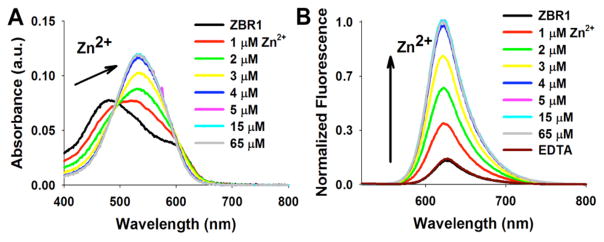
Absorption (A) and normalized fluorescence emission (B) spectra of ZBR1 at different total concentrations of Zn2+. Spectra were acquired on 5 μM solutions of ZBR1 in 100 mM KCl, 50 mM PIPES, pH 7.0 at 25 °C, after the addition of increasing amounts of total ZnCl2, followed 100 μM EDTA. λex = 525 nm.
Figure 3.
Integrated emission intensity of 1 μM ZBR1 vs. [Zn2+]free in aqueous buffer at 25 °C (100 mM KCl, 50 mM PIPES, pH 7.0). λex = 525 nm.
The absorbance and fluorescence emission spectra of ZBR sensors are sensitive to changes in pH owing to their proton-binding properties. Under basic conditions (pH 11), ZBR1 displays strong broad absorbance between 570 and 610 nm corresponding to its fully deprotonated form (Fig. 4A). At pH 7, absorption in this wavelength range is significantly weaker. Furthermore, at acidic pH (pH=2) the broad band centered at 590 nm completely disappears and another weak absorption band appears at 490 nm. The fluorescence response of ZBR1 in the range of pH 2–12 was monitored as well (Fig. 4B). The maximum emission intensity of metal-free probe was observed at pH 7. Reduced emission at high pH is most likely due to the full quenching effect of the pendant amine on the fluorophore, which in turn is abolished at neutral pH values as the amine becomes partially protonated. At acidic pH, the fluorophore itself becomes protonated and the emission efficiency decreases, and effect previously documented for non-functionalized resoru-fin.37 Non-linear fits of the emission intensity as a function of pH afforded two apparent pKa values: pKa1=5.35 ± 0.05 and pKa2=8.15 ± 0.05, respectively. The fitting for ZBR2 gave the pKa values as pKa1=4.4 and pKa2=7.3 (Fig. S10). The incorporation of the chloro substituent has an effect on the apparent pKa. In particular, the first pKa corresponding to deprotonation of the resorufin fluorophore, is reduced by almost one unit owed to the electron withdrawing effect of the Cl atom.
Figure 4.
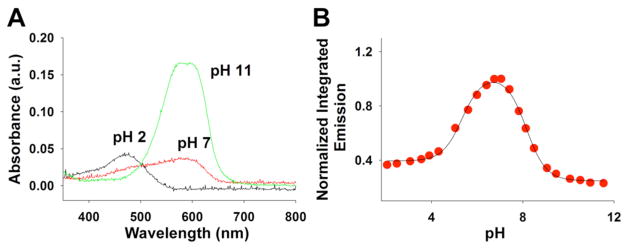
Effect of pH on a 5 μM solution of ZBR1 (100 mM KCl, 25 °C). (A) Representative UV-Vis absorption spectra at different pH values. (B) Plot of the normalized integrated emission intensity vs. pH. The pKa values were obtained from fitting the experimental data (red circles) to a nonlinear model (continuous line).
The fluorescence response of the three ZBR sensors to a variety of biologically relevant metal ions was investigated. As shown in Figs. 5 and S13–14, the treatment of ZBR1 and the other ZBR sensors with alkali and alkaline-earth metals has no effect on the fluorescence whereas paramagnetic transition metal ions such as Mn2+, Fe2+, Co2+, Ni2+ and Cu2+ quench the emission. Iron and manganese, however, may be displaced by zinc, leading to a partial restoration in the fluorescence.
Fig. 5.
Metal selectivity of ZBR1 in aqueous solution at pH 7.0. (50 mM PIPES, 100 mM KCl). For each sample, 5 μM ZBR1 was mixed with 50 μM metal ion of interest (light gray) and then subsequently treated with 50 μM ZnCl2 (dark gray). The integrated fluorescence (550 to 800 nm) after each addition was normalized to the fluorescence of the metal-free sensor. λex = 525 nm.
Live Cell Imaging of ZBR sensors
The cytotoxicity of the ZBR sensors, a critical factor to be considered for their utilization in live cell imaging, was assessed by MTT assays in HeLa cells. Fig. S15 shows the cell viability data for HeLa cells treated with ZBR probes, suggesting that these cells are not damaged following a 24 h treatment with 1 μM ZBR1, ZBR2, or ZBR3. Decreased cell survival (88 ± 5%) occurred following 24 h incubation with 5 μM ZBR1, but no significant cell loss was noticed compared to the control. These results indicate that low micromolar concentrations of ZBR sensors are essentially nontoxic over at least a 24 h period and can be applied to biological studies that require lengthy sensor incubation times.
The ability of the ZBR sensor family to track zinc ions in living cells was investigated. HeLa cells (Fig. 6) were incubated with 5 μM ZBR1 for 30 min at 37 °C before imaging. Because of the low level of endogenous fluorescence from the cells in the red region, in addition to the low quantum yields of the metal-free probes, there is imperceptible background signal before the addition of exogenous zinc (Fig. 6d). The intracellular fluorescence increased in response to addition of exogenous zinc as the 1:2 complex Zn2+/ionophore pyrithione (2-mercaptopyridine-N-oxide) (Fig. 6e). Integration of the fluorescence signal over the cell body indicated an ~6-fold increase when excess Zn2+ is present. The signal decreased substantially after treatment with 50 μM of the chelator TPA (Figs. 6c, f). The Zn2+ response of ZBR2 and ZBR3 was also tested and quantified (Figs. S16 and S17). These results prove that the ZBR sensor family is cell-permeable and can be efficiently used to image intracellular labile Zn2+ within living cells.
Figure 6.
Fluorescence microscopy of live HeLa cells incubated with 5 μM ZBR1 and 5 μM Hoechst 33258 at 37°C for 30 min. A) Bright-field transmission image. B) Nuclear staining by Hoechst 33258. C) Quantification of Zn2+-induced ZBR1 fluorescence response. D) ZBR1 fluorescence without addition of exogenous Zn2+. E) ZBR1 Fluorescence 5 min after treatment with 25 μM Zn2+/pyrithione (1:2). F) ZBR1 Fluorescence 5 min after addition of 50 μM TPA. (mean±SD, N = 22). Scale bar = 25 μm.
Because the localization of small-molecule sensors is affected by a number of factors, the subcellular localization of the ZBR sensor family was investigated in different cell lines including HeLa, RAW 246.7, and NSCs. For example, co-incubation of HeLa cells with ZBR1 and either a Hoechst 33258, MitoTracker Green, or Bac-Mam 2.0 Golgi stain (Figs. 7, S18 and S23) reveals that ZBR1 does not localize significantly to either the nucleus, mitochondria, or Golgi apparatus (Pearson’s correlation coefficients of 0.002, 0.165 and 0.072 respectively). On the other hand, good overlap of ER-Tracker and ZBR1 was observed in HeLa, RAW 246.7 cells, and NSCs (Figs. 7, S19, S20 and S23). The Pearson’s coefficient values were 0.652, 0.575 and 0.699 for the respective co- localizations.
Figure 7.
Colocalization analysis of ZBR1 with organelle-specific markers in HeLa cells incubated with 5 μM ZBR1, 1 μM ER-Tracker and 0.2 μM MitoTracker Green for 30 min, and then treated with 25 μM Zn2+/pyrithione (1:2) on the microscope stage. A) Bright-field image. B) ZBR1. C) MitoTracker Green. D) ER-Tracker E) Overlay of ZBR1 and ER-Tracker. F) Overlay of ZBR1 and MitoTracker Green. Scale bar = 25 μm.
To confirm the spatial localization of ZBR1, 3D images were reconstructed from experiments obtained at different values along the Z-axis. The 3D images of NSCs clearly indicate true colocalization of ZBR1 and ER as opposed to the artifact of organelle overlap when projected down the Z-axis (Figure 8). The other ZBR sensors similarly display good co-localization with ER stains in the tested cell lines (Figs. S21 and S22). Although ZBR1 had moderate-to-strong good co-localization with ER-Tracker in three cell lines, the subcellular localization of small-molecule sensors is adventitious and the accumulation of ZBRs in the ER must be confirmed for each cell lines. Nonetheless, the ability of the ZBR sensors to spontaneously accumulate at specific subcellular locales renders them valuable tools for the study of labile zinc trafficking between the cytoplasm and cellular organelles.
Figure 8.
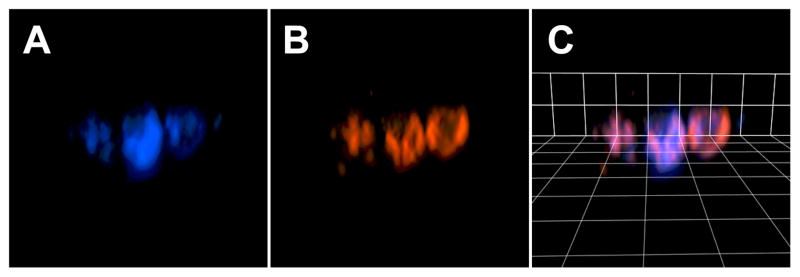
3D-view representations of co-localization analysis within NSCs. A) ER-Tracker fluorescence. B) ZBR1 fluorescence. C) Overlay of ZBR1 and ER-Tracker fluorescence. See Fig. S20 for 2-D images of NSCs. Scale grid = 13 μm.
Peroxynitrite-induced released labile Zn2+ in the ER
Previous studies have shown that peroxynitrite induces ER stress and triggers the release of labile Zn2+ from intracellular stores in neuronal cells.12,42 The source of released labile Zn2+, however, is still under debate owing to the lack of readily applicable organelle-specific sensors for this ion. With our new ER- specific fluorescent probes for labile Zn2+ in hand, we sought to investigate further the interplay between peroxynitrite and Zn2+ homeostasis in the endoplasmic reticulum of NSCs and evaluate the ER as a possible source of the released Zn2+.
Fluorescence imaging of NSCs treated with ZBR1 showed accumulation of endogenous Zn2+ in the ER without the addition of external ionophores. The metal content of the growth media for NSCs contains 2 μM total Zn2+ (information supplied by GIBCO and confirmed by independent measurements in our lab). The use of Zn2+-depleted preparations as growth medium (e.g. DMEM, with an estimated Zn2+ concentration in the nM range) led to a significantly lower ER-localized signal. We treated the cells with 3-morpholinosydnonimine (Sin-1), a reagent that releases NO and superoxide simultaneously at physiological pH,43 which results in the generation of peroxynitrite in-situ with a half-life of 14–26 min in common buffers.44 Images of Zn2+-induced ZBR1 fluorescence in NSCs at different time periods after the addition of 100 μM Sin-1 revealed a loss of signal intensity, consistent with zinc release. As indicated in Figs. 9 and 10, in the first 15 min after addition of peroxynitrite there is a statistically significant decrease (89 ± 4% versus 105 ± 7%, Fig. 10) in the fluorescence intensity of ZBR1. On the other hand, treatment with vehicle (PBS) showed no decrease of fluorescence in the same time period (Fig. 10). The time scale of the observed changes is consistent with the kinetics of decomposition of Sin-1, thus indicating a rapid effect of the reactive species on the Zn2+ levels within the ER. Exogenous Zn2+/pyrithione (1:2) followed by TPA was applied at the end of the experiments to confirm that ZBR1 is still localized in the cells and that the change of fluorescence intensity is indeed produced by a decrease in labile Zn2+ and not by diffusion of the dye out of the organelle, photo-bleaching, or loss of cell viability. To rule out direct interaction between Sin-1 and ZBR1 or the sensor-Zn2+ complex, the effect of Sin-1 on the absorption and emission spectra of ZBR1 in its metal-free and -bound form was tested in the cuvette. The results showed that 100 μM Sin-1 has no significant effect on the emission of ZBR1 or the sensor-Zn2+ complex (Fig. S24). Taken together, these results suggest that the decrease in fluorescence intensity from ZBR1 is due to the mobilization of zinc from the ER in response to RNS-induced stress.
Figure 9.
Representative images of Sin-1-induced ZBR1 fluorescence change in NSCs. A) Bright-field image of NSCs. B) Nuclear staining by Hoechst 33258. C) Fluorescence image of ZBR1 before the addition of 100 μM Sin-1. D) 5 min after the addition of Sin-1. E) 10 min after the addition of Sin-1. F) 15 min after the addition of Sin-1. G) 5 min after the addition of 25 μM Zn2+/pyrithione (1:2). H) 5 min after the addition of 50 μM TPA. Scale bar =25 μm.
Figure 10.
Quantification of Sin-1-induced ZBR1 fluorescence change in NSCs over the course of 15 min. Images (100-msec exposure) were taken before and every minute after the addition of 100 μM Sin-1 (red squares) or phosphate buffer saline (PBS), the vehicle for as the solvent of Sin-1 (black squares). After 15 min, samples were treated with 25 μM Zn2+/pyrithione (1:2) followed by 50 μM TPA. (N ≥ 12; mean±SEM).
Summary and Conclusions
We prepared and characterized a new family of red-emitting fluorescent sensors for mobile Zn2+ based on a benzoresorufin fluorophore functionalized with pyridine- and pyrazine-containing metal binding groups. The new probes, with a conserved [N3O] metal binding motif, have apparent binding affinities comparable to those measured for fluorescein-based counterparts ZPP1 and ZP1, which contain similar binding groups. These results indicate that the benzoresorufin platform can serve as the basis for the design of new red-emitting sensors with predictable binding properties, based upon simple extrapolation of trends in coordinating properties observed for hydroxy-xanthenone containing probes such as fluorescein-based sensors. The sub-nanomolar dissociation constant of ZBR1 and ZBR2 makes them suitable for detecting changes in intracellular labile Zn2+ with little background interference. The new ZBR sensors spontaneously localize in the ER of various tested cell lines and make them valuable for the investigation of zinc trafficking into and out of this organelle. This property confers them with the potential utility for investigating zinc in ER stress and various related phenomena such as UPR. We provide direct observation of the depletion of labile zinc induced by peroxynitrite in the ER of neural stem cells. Further studies will be aimed at characterizing the destination of released Zn2+ under ER stress and the possible downstream signaling pathways thereby triggered.
Supplementary Material
Acknowledgments
This work was supported by NIH grant GM065519 from the National Institute of General Medical Sciences. Spectroscopic instrumentation in the MIT DCIF is maintained with funding from 1S10RR13886-01. We thank Prof. Fred Gage from the Salk Institute, San Diego, for a generous donation of NSCs and Dr. Andrei Loas for insightful discussions.
Footnotes
Supporting Information. X-ray crystallographic data in cif format, NMR spectroscopic data, absorption and emission profiles, pH profiles, metal selectivity plots, cytotoxicity data, images of Zn2+-induced response of all probes, co-localization studies in RAW 246.7 cells and NSCs, absorption and emission profiles of the probes in the presence of Sin-1. This material is available free of charge via the Internet at http://pubs.acs.org.”
References
- 1.Vallee BL, Auld DS. Biochemistry. 1990;29:5647. doi: 10.1021/bi00476a001. [DOI] [PubMed] [Google Scholar]
- 2.Takeda A. Brain Res Rev. 2000;34:137. doi: 10.1016/s0165-0173(00)00044-8. [DOI] [PubMed] [Google Scholar]
- 3.Vallee BL, Auld DS. Acc Chem Res. 1993;26:543. [Google Scholar]
- 4.Andreini C, Banci L, Bertini I, Rosato A. J Proteome Res. 2005;5:196. doi: 10.1021/pr050361j. [DOI] [PubMed] [Google Scholar]
- 5.Dupont CL, Yang S, Palenik B, Bourne PE. Proc Natl Acad Sci. 2006;103:17822. doi: 10.1073/pnas.0605798103. [DOI] [PMC free article] [PubMed] [Google Scholar]
- 6.Eide DJ. Biochim Biophys Acta. 2006;1763:711. doi: 10.1016/j.bbamcr.2006.03.005. [DOI] [PubMed] [Google Scholar]
- 7.Maret W, Krezel A. Mol Med. 2007;13:371. doi: 10.2119/2007-00036.Maret. [DOI] [PMC free article] [PubMed] [Google Scholar]
- 8.Beyersmann D, Haase H. Biometals. 2001;14:331. doi: 10.1023/a:1012905406548. [DOI] [PubMed] [Google Scholar]
- 9.Haase H, Rink L. Annu Rev Nutr. 2009;29:133. doi: 10.1146/annurev-nutr-080508-141119. [DOI] [PubMed] [Google Scholar]
- 10.Fukada T, Yamasaki S, Nishida K, Murakami M, Hirano T. J Biol Inorg Chem. 2011;16:1123. doi: 10.1007/s00775-011-0797-4. [DOI] [PMC free article] [PubMed] [Google Scholar]
- 11.Lin W, Mohandas B, Fontaine C, Colvin R. Biometals. 2007;20:891. doi: 10.1007/s10534-007-9082-y. [DOI] [PubMed] [Google Scholar]
- 12.Bossy-Wetzel E, Talantova MV, Lee WD, Scholzke MN, Harrop A, Mathews E, Gotz T, Han J, Ellisman MH, Perkins GA, Lipton SA. Neuron. 2004;41:351. doi: 10.1016/s0896-6273(04)00015-7. [DOI] [PubMed] [Google Scholar]
- 13.Zhang Y, Wang H, Li J, Jimenez DA, Levitan ES, Aizenman E, Rosenberg PA. J Neurosci. 2004;24:10616. doi: 10.1523/JNEUROSCI.2469-04.2004. [DOI] [PMC free article] [PubMed] [Google Scholar]
- 14.Tong L, Heim RA, Wu S. Free Radic Biol Med. 2011;50:1717. doi: 10.1016/j.freeradbiomed.2011.03.032. [DOI] [PMC free article] [PubMed] [Google Scholar]
- 15.Uehara T, Nakamura T, Yao D, Shi ZQ, Gu Z, Ma Y, Masliah E, Nomura Y, Lipton SA. Nature. 2006;441:513. doi: 10.1038/nature04782. [DOI] [PubMed] [Google Scholar]
- 16.Hoozemans JJM, Scheper W. Int J Biochem Cell Biol. 2012;44:1295. doi: 10.1016/j.biocel.2012.04.023. [DOI] [PubMed] [Google Scholar]
- 17.Jeong J, Walker JM, Wang F, Park JG, Palmer AE, Giunta C, Rohrbach M, Steinmann B, Eide DJ. Proc Natl Acad Sci. 2012;109:E3530. doi: 10.1073/pnas.1211775110. [DOI] [PMC free article] [PubMed] [Google Scholar]
- 18.Ellis CD, MacDiarmid CW, Eide DJ. J Biol Chem. 2005;280:28811. doi: 10.1074/jbc.M505500200. [DOI] [PubMed] [Google Scholar]
- 19.Wang M, Xu Q, Yuan M. Plant Signal Behav. 2011;6:77. doi: 10.4161/psb.6.1.14019. [DOI] [PMC free article] [PubMed] [Google Scholar]
- 20.Song HJ, Stevens CF, Gage FH. Nat Neurosci. 2002;5:438. doi: 10.1038/nn844. [DOI] [PubMed] [Google Scholar]
- 21.Yao J, Mu YL, Gage FH. Protein Cell. 2012;3:251. doi: 10.1007/s13238-012-2033-6. [DOI] [PMC free article] [PubMed] [Google Scholar]
- 22.Brennand KJ, Gage FH. Stem Cells. 2011;29:1915. doi: 10.1002/stem.762. [DOI] [PMC free article] [PubMed] [Google Scholar]
- 23.Pan E, Zhang X-a, Huang Z, Krezel A, Zhao M, Tinberg CE, Lippard SJ, McNamara JO. Neuron. 2011;71:1116. doi: 10.1016/j.neuron.2011.07.019. [DOI] [PMC free article] [PubMed] [Google Scholar]
- 24.Sensi SL, Paoletti P, Koh JY, Aizenman E, Bush AI, Hershfinkel M. J Neurosci. 2011;31:16076. doi: 10.1523/JNEUROSCI.3454-11.2011. [DOI] [PMC free article] [PubMed] [Google Scholar]
- 25.Huang YZ, McNamara JO. J Neurosci. 2012;32:15521. doi: 10.1523/JNEUROSCI.0755-12.2012. [DOI] [PMC free article] [PubMed] [Google Scholar]
- 26.Takeda A, Tamano H. Metallomics. 2012;4:614. doi: 10.1039/c2mt20018j. [DOI] [PubMed] [Google Scholar]
- 27.Nolan EM, Lippard SJ. Acc Chem Res. 2008;42:193. doi: 10.1021/ar8001409. [DOI] [PMC free article] [PubMed] [Google Scholar]
- 28.Walkup GK, Burdette SC, Lippard SJ, Tsien RY. J Am Chem Soc. 2000;122:5644. doi: 10.1021/ja010059l. [DOI] [PubMed] [Google Scholar]
- 29.Wong BA, Friedle S, Lippard SJ. J Am Chem Soc. 2009;131:7142. doi: 10.1021/ja900980u. [DOI] [PMC free article] [PubMed] [Google Scholar]
- 30.Buccella D, Horowitz JA, Lippard SJ. J Am Chem Soc. 2011;133:4101. doi: 10.1021/ja110907m. [DOI] [PMC free article] [PubMed] [Google Scholar]
- 31.Chang CJ, Nolan EM, Jaworski J, Burdette SC, Sheng M, Lippard SJ. Chem Biol. 2004;11:203. doi: 10.1016/j.chembiol.2004.01.017. [DOI] [PubMed] [Google Scholar]
- 32.Nolan EM, Ryu JW, Jaworski J, Feazell RP, Sheng M, Lippard SJ. J Am Chem Soc. 2006;128:15517. doi: 10.1021/ja065759a. [DOI] [PMC free article] [PubMed] [Google Scholar]
- 33.Zhang X-a, Hayes D, Smith SJ, Friedle S, Lippard SJ. J Am Chem Soc. 2008;130:15788. doi: 10.1021/ja807156b. [DOI] [PMC free article] [PubMed] [Google Scholar]
- 34.Ghosh SK, Kim P, Zhang X-a, Yun S-H, Moore A, Lippard SJ, Medarova Z. Cancer Res. 2010;70:6119. doi: 10.1158/0008-5472.CAN-10-1008. [DOI] [PMC free article] [PubMed] [Google Scholar]
- 35.Lukhtanov EA, Vorobiev AV. J Org Chem. 2008;73:2424. doi: 10.1021/jo702422v. [DOI] [PubMed] [Google Scholar]
- 36.Apfel UP, Buccella D, Wilson JJ, Lippard SJ. Inorg Chem. 2013;52:3285. doi: 10.1021/ic302793w. [DOI] [PubMed] [Google Scholar]
- 37.Bueno C, Villegas ML, Bertolotti SG, Previtali CM, Neumann MG, Encinas MV. Photochem Photobiol. 2002;76:385. doi: 10.1562/0031-8655(2002)076<0385:tesior>2.0.co;2. [DOI] [PubMed] [Google Scholar]
- 38.Palmer TD, Takahashi J, Gage FH. Mol Cell Neurosci. 1997;8:389. doi: 10.1006/mcne.1996.0595. [DOI] [PubMed] [Google Scholar]
- 39.Takahashi J, Palmer TD, Gage FH. J Neurobiol. 1999;38:65. [PubMed] [Google Scholar]
- 40.Vinkenborg JL, Nicolson TJ, Bellomo EA, Koay MS, Rutter GA, Merkx M. Nat Meth. 2009;6:737. doi: 10.1038/nmeth.1368. [DOI] [PMC free article] [PubMed] [Google Scholar]
- 41.Kowalczyk T, Lin Z, Voorhis TV. J Phys Chem A. 2010;114:10427. doi: 10.1021/jp103153a. [DOI] [PubMed] [Google Scholar]
- 42.Zhang Y, Wang H, Li J, Dong L, Xu P, Chen W, Neve RL, Volpe JJ, Rosenberg PA. J Biol Chem. 2006;281:9460. doi: 10.1074/jbc.M510650200. [DOI] [PubMed] [Google Scholar]
- 43.Feelisch M, Ostrowski J, Noack E. J Cardiovasc Pharmacol. 1989;14:S13. [PubMed] [Google Scholar]
- 44.Martin-Romero F, Gutierrez-Martin Y, Henao F, Gutierrez-Merino C. J Fluoresc. 2004;14:17. doi: 10.1023/b:jofl.0000014655.89256.bd. [DOI] [PubMed] [Google Scholar]
Associated Data
This section collects any data citations, data availability statements, or supplementary materials included in this article.



